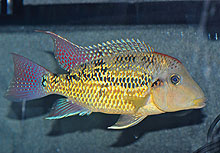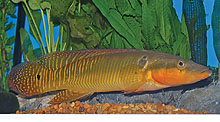WHAT'S NEW ACROSS THE WORLD
Select date in side bar to go to a What's New of previous issues
| What's New
©by Laif DeMason
At the time of this writing, we’ve already seen some unseasonably cold weather in many parts of the USA. Now the holidays are almost behind us and it is time to settle in for a long winter. Naturally, a fishkeeper will now concentrate on their beloved pets and do some long-needed upkeep and re-arrangement. If you are lucky enough to be near a large city, then check out the frequent swap meetings or auctions. Of course there is always your favorite local cichlid shop to visit as well.
Here’s “what’s new” on the cichlid scene: |
Lake Tanganyika
Collections continue around the lake, except for the small Burundi coast. There has been a swell of new exporters licensed to ship, trying to get a piece of worldwide sales. However I’m not sure even half will survive in this difficult business. A new Kigoma outfit has renewed efforts there and in the northern Congo as well.
| WHAT'S NEW: LAKE TANGANYIKA |

Usually collected near Chituta, Zambia, Paracyprichromis nigripinnis blue neon is found lake-wide. Recently Tanzanians have tapped the population near Ulwile Island in the Kipili area as a source for exports. Naturally the Kipili location yields a bit larger individuals since the area in Zambia has been harvested for decades. Photo by A. Konings.
|

The demand for goby cichlids has climbed since the closing of their usual source in Burundi a couple of years back. Eretmodus varieties have a bigger demand since there are many color types at various locations. Pictured here is the Eretmodus cyanostictus from Kasanga, Tanzania, one of the blue point types. Photo by A. Konings.
|

Sometimes sold as Xenotilapia “Yellow Princess” or even X. ‘flavipinnis’ Lupita, this fish is really X. sp. ‘bathyphilus yellow’ and found at several places lake-wide. Here is the fish from Lupita Island near Kipili in Tanzania. The yellow dorsal fin sports two or three interesting ocellated spots which seem to vary numerically by location. Photo by T. Andersen.
|

Where have all the Neolamprologus nigriventris gone? A question asked by many. Well, the original collected numbers decades ago were small compared to most exported cichlids because usually only few are seen in southern Congo. Naturally, a difficult place to catch most fishes, none have been collected recently. The captive bred stocks held by a few hobbyists produce infrequently.
|
Lake Malawi
What can I say about Lake Malawi cichlids? Hobbyists seem to only want the rarest of the rare wild cichlids found there and nothing else. Of course this is a difficult order to fill! Unfortunately, most of the usual captive bred forms have low demand or are also much cheaper from Far East producers. So for local stores, quality bred cichlids are slow sellers….

Exported as ‘Haplochromis insignis’ in the early days of the Tanzanian coast collections in the 1990s, this fish is of course not the true egg-robber insignis! This fish is more correctly named Protomelas sp. ‘spilonotus tanzania’ or Orange Belly Hap, but certainly not the same as the Sulfur Head Hap, P. spilonotus.
|

A little known fish from Mbamba Island, Tanzania is the so-called yellow Taiwan Steveni or Protomelas sp. ‘steveni taiwan’ yellow. It is similar to the form with red anal fins at nearby Higga Reef. The Mbamba Island yellow form is not exported often but some have been sent due to “rare fish” demand. Photo by A. Konings.
|

The Placidochromis electra form from the Ft. Maguire, Malawi, area is known as the Black Face electra and sports a black face at an early age. Somewhat popular in the recent past due to its promotion as a new variety, sales have slowed over recent months. Photo by A. Konings.
|

Interestingly-colored man-made peacocks or Aulonocara types come around now and again. Pictured here is an OB yellow variety, sporting rich yellow body coloration. These fish are usually hybrids of different species and selected for body shape and color. Of course this fish is not found in Lake Malawi.
|

Reportedly from the Rio Sinu area in Colombia, ‘Geophagus’ sp. ‘Alto Sinu’ is also called the Gold Dust Eartheater. Likely related to ‘G.’ steindachneri, this fish is infrequently imported and sometimes offered from breeders.
|

One of the several very large pike cichlids, often imported at an 8 to 10 inch size, is Crenicichla zebrina. This fish is from the upper Rio Ventuari in Venezuela. If you plan to keep this fish make sure it has plenty of room and a covered tank!
|
Select date in side bar to go a What's New of previous issues |









